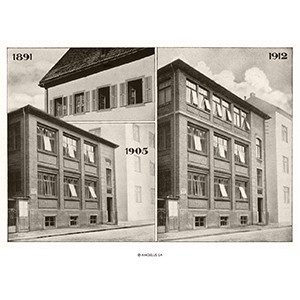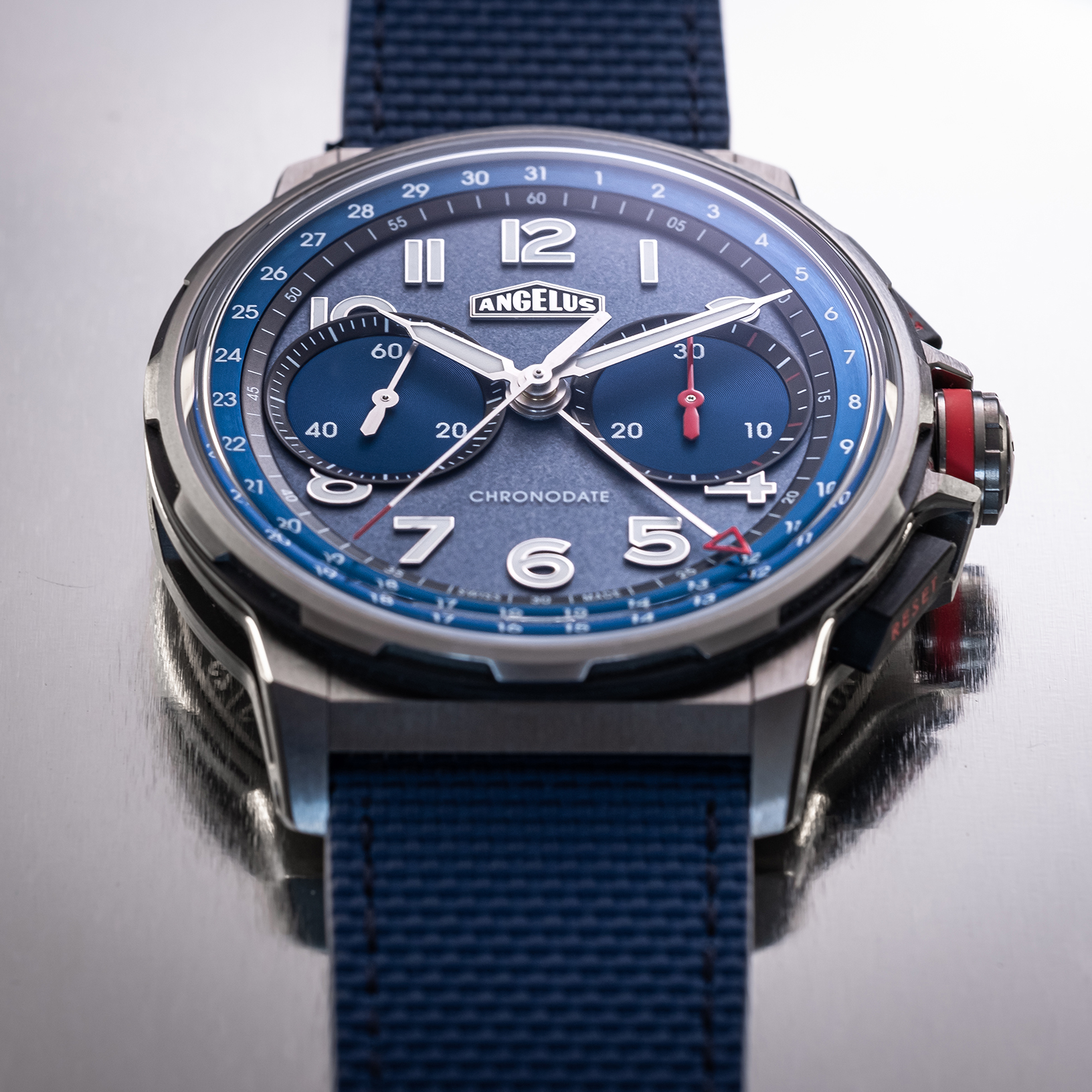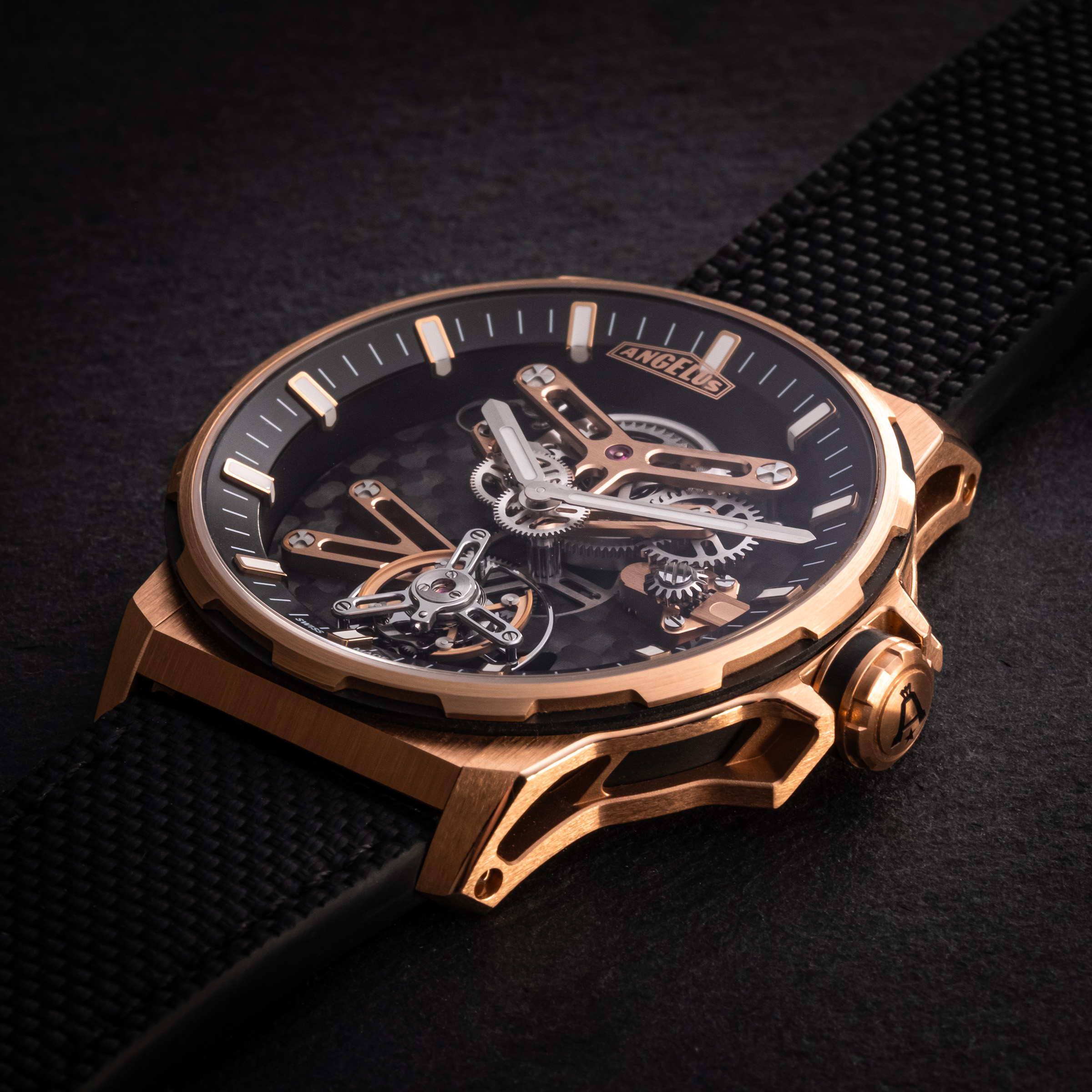HISTORY
Angelus was founded by the brothers Stolz with the establishment of a watchmaking Manufacture in Le Locle, Switzerland. Over the past century, Angelus forged a fine reputation for creating exceptional chronograph and multi-complication wristwatches, multi-display travel clocks with long power reserves, and alarm watches.

-
 1891
1891Brothers Albert and Gustav Stolz – distinguished watchmakers and former students of Henri Sandoz who was director of the Tavannes Watch Company – establish their Angelus watchmaking manufacture in Le Locle, Switzerland, a city world renowned for high-end watchmaking. They began with just a room on the Rue du Marais, modest beginnings for what would become an important brand.
-
1898
After qualifying as a watchmaker, the third brother, Charles Stolz, joins Angelus.
-
 1902
1902Angelus was awarded a gold medal at the International Exposition in Paris and the Médaille de Vermeil at the International Exposition in Lille, France.
-
 1904
1904The success of the company allows the brothers to employ 15 skilled artisans, with more and more work being carried out in-house. The brothers decide to start making their own movement blanks (ébauches) and to build their own manufacture. Angelus’ specialty becomes complicated movements including repeaters and chronographs. The superb craftsmanship is recognized by prestigious awards at international fairs and expositions.
-
 1905
1905Angelus awarded gold medal at the International Exposition in Liège, Belgium.
-
1906
Angelus awarded the Grand Diplôme d’Honneur in Milan, Italy.
-
 1913
1913Angelus’ first advertisement.
-
 1914
1914Angelus awarded the Grand Prix at the Swiss National Exhibition in Bern.
-
1914
Gustave Stolz takes over the reins at the renowned manufacture of Le Phare, while still carrying out his duties for Angelus, further strengthening the already good relations between the two companies. This relationship explains why Le Phare movements can be found in some Angelus pocket watch chronographs and repeaters.
-
1914
The First World War proves an obstacle to the development of Angelus, but does not prevent it from creating a repeater timepiece for blind people that is offered to returning soldiers who have suffered facial injuries. This gesture earns the Stolz brothers a letter of thanks from French army general Marshal Joffre.
-
1920
The world of watchmaking starts to harness the luminescent properties of radium-based materials to create glow-in-the-dark indications. Being able to read the time in the dark signals a decline in the popularity of repeater watches, one of the jewels in Angelus’ crown. In light of this, the brand decides to diversify its production with alarm watches, and alarm and repeater table clocks, a move that helps Angelus ride out the Great Depression.
-
 1925
1925Angelus launches the first of its beautifully crafted in-house monopusher chronographs 29.3 and 31.6mm (13 and 14 lines) in diameter, which are activated by pressing a single pusher in the crown.
-
 1926
1926As confirmation of the quality of its timepieces, Angelus is awarded a gold medal at the Sesquicentennial International Exposition in Philadelphia, USA.
-
 1929
1929The precision of Angelus movements is highlighted by the awards of three first-class certificates for accuracy and three certificates for complications from the observatory in Le Locle.
-
 1930
1930Angelus starts selling the smallest – only 32mm x 21mm (10.5 lines) – 8-day movement in the world with an excellent precision of +/- 1 minute per week. This movement actually has a potential power reserve of 10 days. It remains the smallest 8-day movement in the world to this day.
-
 1933
1933Angelus’ first advertisement for the chronograph wristwatch.
-
 1935
1935Angelus begins making two-pusher chronographs based on 29.33mm and 33.84mm (13 and 15 lines) manufacture movements with 30- or 45-minute counters. The first two-pusher chronographs appeared in 1933 and were made by Breitling, however the complication only becomes widespread after 1935, with Angelus and Universal prominent exponents of this type of chronograph.
-
 1936
1936Angelus launches calibre SF240, the smallest 8-day alarm movement then available. This movement is also produced without alarm function.
-
 1936
1936Angelus creates the Dateclock, the first alarm clock equipped with full calendar – day, date and month. It comes in a compact, easy-to-fold format and is the perfect accompaniment for the ever-increasing number of globetrotters that have been empowered by commercial air travel and affordable private automobiles, as well as high-speed roads and railways.
-
 1937
1937Angelus launches the Foursome compact table clock, featuring an 8-day power reserve, automatic calendar, barometer, and thermometer.
-
 1940
1940The Hungarian Air Force chooses Angelus as its supplier of chronographs.
-
 1941
1941For Angelus’ 50th anniversary, the brand moves to a superb new manufacture in Le Locle on Rue Piaget. Angelus is employing approximately 90 people. On this occasion, Angelus unveils an astonishing mini-clock: the Naveo. Taking the form of a ship’s wheel, the Naveo has an 8-day power reserve, automatic calendar, barometer, thermometer and hygrometer. In the same year, Albert Stolz’s son, André, takes over the reins of the company.
-
 1942
1942Angelus causes a sensation in the world of watchmaking by launching the world’s first series chronograph with calendar. Initially christened Chronodate (Chronodato from 1943 onwards), this remarkable chronograph is equipped with the 32.8mm (14 lines) calibre SF217, which was derived from the calibre SF215 launched earlier in the year – and features 17 or 19 jewels and a 45-minute counter.
Chronodato’s date is indicated by a central hand pointing to a chapter ring on the periphery of the dial; day and month are respectively displayed in windows at 6 and 12 o’clock. The Chronodato rapidly becomes Angelus’ top selling watch and goes on to become an icon of Swiss-made chronographs.
With the exception of a few non-production models made by Patek Philippe featuring a calendar in 1937 and perpetual calendar in 1941, this was the first time that the date appeared on a production chronograph wristwatch.
-
 1943
1943Panerai equips its legendary Radiomir Mare Nostrum chronograph with Angelus’calibre SF215, however, the watch stays in the prototype stage.
-
 1944
1944Angelus launches a waterproof sports watch. Its generous 40 mm in diameter size is remarkable for the era.
-
 1945
1945Angelus creates its most sophisticated travel instrument yet, the Sixome, featuring an 8-day power reserve, automatic calendar, barometer and thermometer – like the Foursome – in addition to a hygrometer and a compass.
-
 1946
1946With commercial air transport becoming more and more popular, Angelus creates “Planète avion” (“Planet aircraft”) which is both a timepiece and a sculpture.
-
 1947
1947Angelus launches the Folioluxe travel clock featuring a full calendar, alarm and 8-day movement and stands out for its moon phase indication.
-
1947
Intercontinental transport is well and truly a reality now so Angelus creates Multitime, an alarm travel clock featuring date and world time.
-
 1948
1948Angelus launches a new chronograph movement, the 27mm (12 lines) calibre SF250 with 30-minute counter. This development paves the way for the brand’s masterpiece, the Chrono-Datoluxe.
The Chrono-Datoluxe is the world’s first series chronograph featuring a digital date display. It was at the same time the first wristwatch chronograph with a big date – two Arabic numerals, each one on a discrete, coaxial disc, displayed in a window at 12 o’clock, with the day also displayed in a window next to the date. A moon phase at 6 o’clock completes the indications.
Angelus also made non-chronograph calendar watches both with moon phase (the Datoluxe) and without (the Dato 12) derived from the Chrono-Datoluxe calendar complication.
-
 1954
1954Angelus develops its own date window display for automatic winding movements, enabling the brand to make even thinner watches.
-
 1955
1955Angelus 8-day calibre SF240 is chosen by Panerai to equip watches for the Italian navy. Panerai watches equipped with the Angelus calibre SF240 can be recognized by the small seconds at 9 o’clock. This now iconic Panerai design element can be directly attributed to the Angelus calibre SF240.
-
 1956
1956Angelus launches the Datalarm, the first wristwatch ever featuring both alarm and date function, the latter displayed in a window at 3 o’clock. The Datalarm comes in different versions, including a world-timer with 24-hour chapter ring on the bezel and, inside on the dial, the names of 24 cities, each representing a world time zone.
-
 1958
1958Angelus launches an extraordinary wristwatch, the Tinkler, which is both the first ever automatic repeater wristwatch as well as the first waterproof repeater wristwatch. The Tinkler’s repeater mechanism – activated by a ‘pump’ pusher similar to that used in Angelus’ waterproof chronographs – strikes on the hour and quarter hours.
The Tinkler is so ahead of its time that only approximately 100 pieces were produced. This rarity means that the Tinkler becomes highly sought-after by watch collectors years later.
-
 1959
1959Angelus creates Globe Mystère, a remarkable table clock with a double-sided dial appearing to float within a globe. The whole movement is hidden in the base of this timepiece.
-
 1960
1960Angelus makes its final chronograph of the 2oth century – a monopusher for doctors featuring scales around the periphery of the dial between 12 o’clock and 3 o’clock for measuring breathing and pulse rate, with the displays magnified by special optics integrated into the glass.
-
 1978
1978Angelus presents yet another notable striking wristwatch, a five-minute repeater, developed in collaboration with movements manufacture Dubois Dépraz.
-
2011
Angelus is bought by Manufacture La Joux-Perret.
-
 2015
2015After four years developing the next generation of Angelus timepieces at its manufacture in La Chaux-de-Fonds, a stone’s throw from the Stolz brothers’ first watchmaking atelier, Angelus unveils its collection of the 21st century, upholding the brand’s reputation for innovation.



